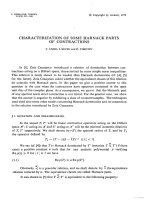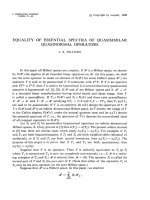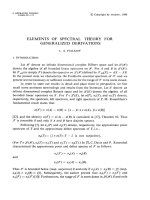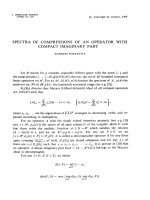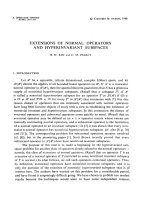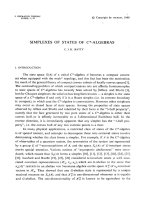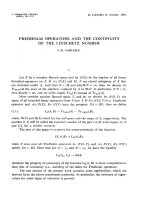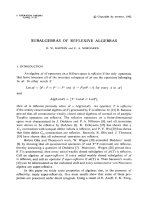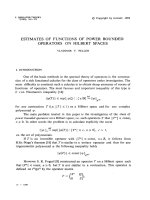Báo cáo toán học: "Extension of Strongly Regular Graphs" potx
Bạn đang xem bản rút gọn của tài liệu. Xem và tải ngay bản đầy đủ của tài liệu tại đây (93.89 KB, 5 trang )
Extension of Strongly Regular Graphs
Ralucca Gera
∗
Department of Applied Mathematics
Naval Postgraduate School, Monterey, CA 93943
email: , phone (831) 656-2206, fax (831) 656-2355
and
Jian Shen
Department of Mathematics
Texas State University, San Marcos, TX 78666
email: , phone: (512) 245-3740
Submitted: Sep 30, 2007; Accepted: Feb 2, 2008; Published: Feb 11, 2008
Mathematics Subject Classification: 05C75
Abstract
The Friendship Theorem states that if any two people in a party have exactly
one common friend, then there exists a politician who is a friend of everybody.
In this paper, we generalize the Friendship Theorem. Let λ be any nonnegative
integer and µ be any positive integer. Suppose each pair of friends have exactly λ
common friends and each pair of strangers have exactly µ common friends in a party.
The corresponding graph is a generalization of strongly regular graphs obtained by
relaxing the regularity property on vertex degrees. We prove that either everyone
has exactly the same number of friends or there exists a politician who is a friend
of everybody. As an immediate consequence, this implies a recent conjecture by
Limaye et. al.
Key Words: strongly regular graph, Friendship Theorem
1 Introduction and Motivation
In this paper all graphs G = (V (G), E(G)) are simple. The neighborhood of a vertex
v ∈ V (G) is N(v) = {u : (u, v) ∈ E(G)}. The join, denoted G
1
∨ G
2
, of two graphs G
1
and G
2
is the graph with vertex set V (G
1
) ∪V (G
2
) and edge set E(G
1
) ∪E(G
2
) ∪{(u, v) :
u ∈ V (G
1
) and v ∈ V (G
2
)}. Also, the disjoint union, denoted by G
1
+ G
2
, of two graphs
∗
Research supported by the Research Initiation Program Grant at the Naval Postgraduate School.
the electronic journal of combinatorics 15 (2008), #N3 1
G
1
and G
2
is the graph obtained from G
1
and G
2
with V (G
1
+ G
2
) = V (G
1
) ∪ V (G
2
) and
E(G
1
+ G
2
) = E(G
1
) ∪ E(G
2
).
We use the notation d(u) = |N(u)| and δ(u, v) = |N(u) ∩ N(v)| to denote the number
of neighbors of u (the degree of u) and the number of common neighbors of u and v,
respectively. An n-vertex graph is called strongly regular, denoted SRG(n, r, λ, µ), if
there exist nonnegative integers r, λ, µ such that for all vertices u, v ∈ V (G),
δ(u, v) =
r if u = v;
λ if u = v and (u, v) ∈ E(G);
µ if u = v and (u, v) ∈ E(G).
Many generalizations of strongly regular graphs have been considered in the literature.
For example, the t-tuple regular graphs were introduced by Cameron [2]; the NR-regular
graphs (also known as the Gamma-Delta regular graphs) were defined by Godsil and
McKay [5]; and the strong graphs were defined by Seidel [7]. Since every strongly regular
graph has exactly three eigenvalues, graphs with few eigenvalues are also considered as
generalizations of strongly regular graphs. In particular, graphs with three eigenvalues
were studied by Van Dam [8]; graphs with three Laplacian eigenvalues were studied by
Van Dam and Haemers [10]; and graphs with four eigenvalues were studied by Van Dam [9]
and by Van Dam and Spence [11].
In this paper, we yet introduce another extension of strongly regular graphs, from a
different direction. In 1966, Erd˝os, R´enyi, and S´os [1, 4] proved the following interesting
result, commonly referred to as the Friendship Theorem: If δ(u, v) = 1 for any two distinct
vertices u, v in a graph G, then G = K
1
∨ (mK
2
), where mK
n
denotes the disjoint union
of m copies of the complete graph on n vertices. A nice interpretation of the theorem
is that if any two people in a party have exactly one common friend, then there exists a
politician who is a friend of everybody.
We generalize the Friendship Theorem as follows. Let λ and µ be any nonnegative
integers. A graph G is call a (λ, µ)-graph if every pair of adjacent vertices have λ com-
mon neighbors, and every pair of non-adjacent vertices have µ common neighbors. Thus,
(λ, µ)-graphs are generalizations of strongly regular graphs obtained by relaxing the reg-
ularity property on vertex degrees. In particular, the Friendship Theorem asserts that
K
1
∨ (mK
2
) is the only type of (1, 1)-graphs. Since strongly regular graphs have been
studied extensively in the literature, we are interested in studying irregular (λ, µ)-graphs.
One might assume that there are many (λ, µ)-graphs that are not regular (and thus not
strongly regular). To the contrary, we prove that K
1
∨ (mK
λ+1
) is the unique type of con-
nected irregular (λ, µ)-graphs. This extends the Friendship Theorem. As an immediate
consequence, our result implies the following recent conjecture by Limaye, Sarvate, Stan-
ica, and Young [6] on strongly bi-regular graphs. An n-vertex graph G is called strongly
bi-regular, denoted SBRG(n, r, s, λ, µ), if G is not regular and there exist nonnegative
integers r, s, λ, µ with r = s such that for all vertices u, v,
δ(u, v) =
r or s if u = v;
λ if u = v and (u, v) ∈ E(G);
µ if u = v and (u, v) ∈ E(G).
the electronic journal of combinatorics 15 (2008), #N3 2
Conjecture 1 (Limaye, Sarvate, Stanica, and Young, 2005). Let G be a connected
SBRG(n, r, s, λ, µ). Then G = K
1
∨ mK
λ+1
, where n = m(λ + 1) + 1.
2 Characterization of Irregular (λ, µ)-graphs
In this section we prove that K
1
∨ mK
λ+1
is the only type of connected irregular (λ, µ)-
graphs. A nice interpretation of the result is that if each pair of friends has exactly λ
common friends and each pair of strangers have exactly µ (µ ≥ 1) common friends in
a party, then either everyone has exactly the same number of friends or there exists a
politician who is everybody’s friend.
Theorem 1. Suppose G is an irregular (λ, µ)-graph on n vertices. Then one of the
following is true:
i) µ = 0 and G = mK
λ+2
+ tK
1
(disjoint union of m copies of K
λ+2
and t copies of
K
1
), where n = m(λ + 2) + t.
ii) µ = 1 and G = K
1
∨ (mK
λ+1
), where n = m(λ + 1) + 1.
Proof. If µ = 0, then G has no pair of vertices with distance two apart. Thus each
component of G is a complete graph. Since G is a (λ, µ)-graph, each complete of G is
either K
λ+2
or K
1
; that is, G = mK
λ+2
+ tK
1
. This proves part i) of the theorem.
Suppose now µ = 0. For all distinct vertices u, v, define
(u, v) =
1 if (u, v) ∈ E(G);
0 if (u, v) ∈ E(G).
Claim 1: (µ − (u, v))(d(u) − d(v)) = 0 for any two distinct vertices u, v.
Proof of Claim 1. Let = (u, v), A = N(u) − N(v) − {v}, B = N(u) ∩ N(v), and
C = N (v) − N(u) − {u}. Let E(X, Y ) be the set of edges with one vertex in X and the
other vertex in Y , and E(x, Y ) be the set of edges with one vertex being x ∈ X and the
other vertex in Y . Then, for each b ∈ B,
|E(b, A)| =
|N(b) ∩ N(u)| − |E(b, B)| if (u, v) ∈ E(G);
|N(b) ∩ N(u)| − |E(b, B)| − 1 if (u, v) ∈ E(G).
= λ − |E(b, B)| −
and
|E(B, A)| =
b∈B
|E(b, A)| =
b∈B
(λ − ) −
b∈B
|E(b, B)| = (λ − )|B| − 2|E(B, B)|.
Similarly,
|E(B, C)| =
b∈B
(|N(b) ∩ N (v)| − |E(b, B)| − ) = (λ − )|B| − 2|E(B, B)|.
the electronic journal of combinatorics 15 (2008), #N3 3
Thus
|E(A, B)| = |E(B, A)| = |E(B, C)| = |E(C, B)|. (1)
Next we count |E(A, C)| in two different ways. First, for each a ∈ A, we have
|E(a, C)| =
|N(a) ∩ N(v)| − |E(a, B)| if (u, v) ∈ E(G);
|N(a) ∩ N(v)| − |E(a, B)| − 1 if (u, v) ∈ E(G).
= µ − |E(a, B)| − .
Thus
|E(A, C)| =
a∈A
|E(a, C)| =
a∈A
(µ − |E(a, B)| − ) = (µ − )|A| − |E(A, B)|.
Similarly,
|E(C, A)| =
c∈C
|E(c, A)| =
c∈C
(µ − |E(c, B)| − ) = (µ − )|C| − |E(C, B)|.
By (1),
(µ − )|A| = |E(A, C)| + |E(A, B)| = |E(C, A)| + |E(C, B)| = (µ − )|C|
and thus
(µ − )(d(u) − d(v)) = (µ − )((|A| + |B| + ) − (|C| + |B| + )) = (µ − )(|A| − |C|) = 0.
This completes the proof of Claim 1.
Recall that µ = 0. Then µ = 1, since otherwise, by Claim 1, G would be regular. We
now fix a vertex u and define V
1
= {v ∈ V : d(v) = d(u)} and V
2
= {v ∈ V : d(v) = d(u)}.
Since G is irregular, V
1
and V
2
are nonempty and form a partition for V .
Claim 2: Every vertex in V
1
is adjacent to every vertex in V
2
.
Proof of Claim 2. Suppose otherwise (x, y) ∈ E(G) for some x ∈ V
1
and some y ∈ V
2
.
Then (x, y) = 0. By Claim 1, d(x) = d(y), contracting the definition for V
1
and V
2
.
Claim 3: Either |V
1
| = 1 or |V
2
| = 1.
Proof of Claim 3. Suppose otherwise |V
1
| ≥ 2 and |V
2
| ≥ 2. Let i = 1, 2. If there were a
pair of non-adjacent vertices u, v in V
i
(i = 1, 2), then by Claim 2, µ = δ(u, v) ≥ |V
3−i
| ≥ 2,
contradicting µ = 1. Thus there is no pair of non-adjacent vertices in each V
i
. By Claim
2, G = K
n
, contradicting the irregularity of G.
By Claim 3, without loss of generality, let V
1
= {u}. By Claim 2, u is adjacent to every
vertex in V
2
. Thus µ = 1 implies that G[V
2
], the subgraph of G induced by V
2
, is a disjoint
union of complete graphs K
λ
. Therefore G = K
1
∨ (mK
λ+1
) with n = m(λ + 1) + 1. This
proves the theorem.
the electronic journal of combinatorics 15 (2008), #N3 4
Remark 1. Since strongly bi-regular graphs are a special case of irregular (λ, µ)-graphs,
Theorem 1 implies Conjecture 1 immediately.
Remark 2. We note that our definition of (λ, µ)-graphs extends the concept of all three
types of graphs discussed in [3]. Let G be the complement graph of G and N[u] =
N(u) ∪ {u} be the closed neighborhood of a vertex u. It can easily be observed that a
graph G with n vertices is uniformly (2, r)-regular (that is, |N (u) ∪ N(v)| = r for each
pair of distinct vertices u, v) iff G is an (n − r − 2, n − r)-graph; G is uniformly cl-nbhd
(2, r)-regular (that is, |N[u] ∪ N[v]| = r for each pair of distinct vertices u, v) iff G is an
(n − r, n − r)-graph; G is k-frienly (that is, |N(u) ∩ N(v)| = r for each pair of distinct
vertices u, v) iff G is a (k, k)-graph. Therefore, Theorem 1 implies [3, Corollaries 1, 2, 3,
4].
Acknowledgement. We thank three referees for many valuable comments leading to
the clear presentation of the paper.
References
[1] M. Aigner, G. Ziegler. Proofs from The Book. Springer-Verlag, Berlin, 1999.
[2] P. Cameron. Strongly regular graphs, Chapter 12 in Selected Topics in Graph Theory,
pp. 337–360, L. Beineke and R. Wilson (Eds.), Academic Press, New York, 1978.
[3] K. Bragan, D. Hoffman, P. Johnson. Inferring regularity by a neglected theorem of
Ryser. Bull. Inst. Combin. Appl. 50 (2007), 47–51.
[4] P. Erd˝os, A. R´enyi, V. S´os. On a problem of graph theory. Studia Sci. Math. 1 (1966),
215–235.
[5] C.D. Godsil, B.D. MaKay. Graphs with regular neighborhoods. Combinatorial math-
ematics, VII (Proc. Seventh Australian Conf., Univ. Newcastle, Newcastle, 1979),
pp. 127–140, Lecture Notes in Math., 829, Springer, Berlin-New York, 1980.
[6] N.B. Limaye, D.G. Sarvate, P. Stanica, P. Young. Regular and strongly regular planar
graphs. J. Combin. Math. Combin. Comput. 54 (2005), 111–127.
[7] J.J. Seidel. Strongly regular graphs. 1969 Recent Progress in Combinatorics (Proc.
Third Waterloo Conf. on Combinatorics, 1968), pp. 185–198, Academic Press, New
York.
[8] E.R. van Dam. Nonregular graphs with three eigenvalues. J. Combin. Theory Ser. B
73 (1998), 101-118.
[9] E.R. van Dam. Regular graphs with four eigenvalues. Linear Algebra Appl. 226/228
(1995), 139–162.
[10] E.R. van Dam, W.H. Haemers. Graphs with constant µ and µ. Discrete Math. 182
(1998), no. 1-3, 293–307.
[11] E.R. van Dam, E. Spence. Small regular graphs with four eigenvalues. Discrete Math.
189 (1998), 233-257.
the electronic journal of combinatorics 15 (2008), #N3 5

